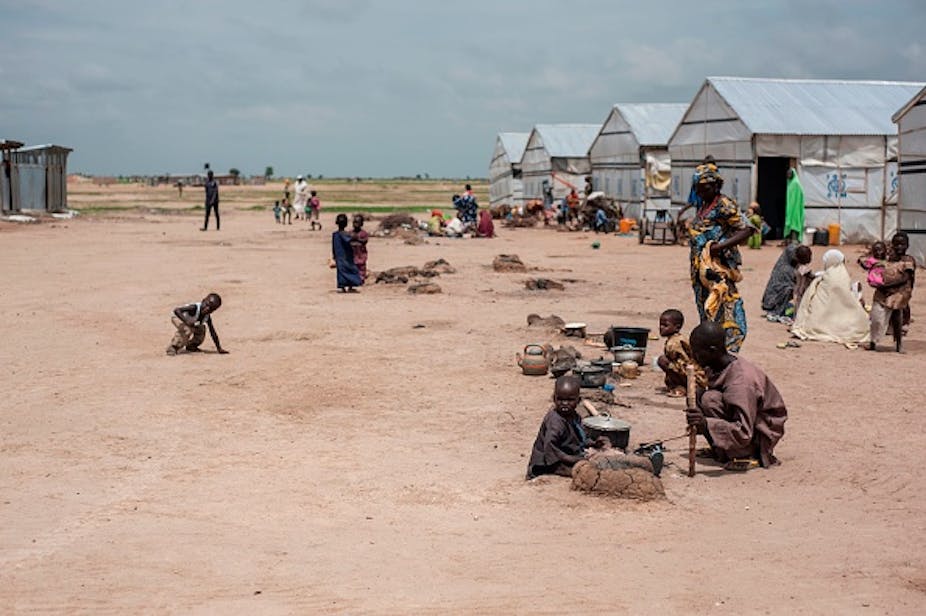Internal displacement of people has been a recurring challenge in Nigeria. There are several factors that contribute to it, but violent conflicts caused by religious extremism and ethnic clashes remain the most important.
Violent attacks by Boko Haram since 2009 have displaced over two million people. Between 2005 and 2021, over 8,000 people lost their lives to clashes between farmers and herders across Nigeria, with hundreds of thousands also displaced.
Children account for about 60% of the internally displaced persons in Nigeria. Many of them live in camps and one in four are under the age of five. These children are vulnerable to abuse, violence and malnutrition. They also lack access to education, healthcare and a safe environment, among other basic amenities.
In my research, I examined the legal protection of children in five camps for internally displaced people. My study specifically focused on access to education, health and nutrition, protection from violence and child labour.
I collected data from five camps: Ngala camp in Borno state, Maraban Kajuru camp in Kaduna state, Kuchingoro camp in Abuja, the capital city, Daudu Camp 1 and Daudu Camp 2, both in Benue state.
My data covered the number of children and the infrastructure available to enable access to education, healthcare and protection from violence and child labour. I found that most internally displaced children faced violation of all these rights on a regular basis.
Nigeria’s child’s right laws
The major international instrument on the protection of the rights of children is the UN Convention on the Rights of the Child. At the regional level, the African Charter on the Rights and Welfare of the Child is the instrument for protection for children. These instruments provide the basis for many national frameworks for child protection globally. In 1991, Nigeria adopted the UN Convention on the Rights of the Child. And in 1999 it adopted the African Charter on the Rights and Welfare of the Child.
As required by section 12 of the Nigerian constitution, Nigeria domesticated the Child’s Rights Act.
But despite the ratification and domestication of these laws, the Child’s Right Act is not applicable to the whole country. It falls under the residual legislative list of the Nigerian constitution. This means that for the Child’s Right Act to be applicable in any state in Nigeria, it must take legislative step to enact a state version of the act. To further supplement the Child’s Right Act, the federal legislature enacted the Violence Against Persons (Prohibition) Act in 2015. It, too, requires state enactment.
Unfortunately, only one out of the six states of the north-east region, which has the highest number of internally displaced children, has domesticated the Child’s Right Act.
Challenges of internally displaced children
The lack of structured classrooms, adequate teachers, writing materials and instructional materials is an impediment to education for displaced children. Schools in the host communities that could provide the opportunity for education often discriminate against displaced children. The schools require displaced children to pay higher fees. Consequently, many displaced children have to stay out of school. This happens despite a special project department under the Universal Basic Education Commission with the responsibility of education of children in emergency situations such as internal displacement.
Inadequate resources have made it challenging to realise the right to healthcare services too. Children have died of malnutrition and illnesses such as malaria and cholera due to lack of medication and quality food. I found that while there are medical structures in the camps I studied, the shortage of medicines and personnel at all times remains an impediment to providing quality healthcare services. Thus, many displaced persons rely on occasional interventions from humanitarian actors, which is not always a reliable source of healthcare.
Although camp officials and displaced persons have sometimes claimed not to be aware of any form of violence against children, my study and media reports show evidence of rape, gender-based violence, child or forced marriage and other forms of violence.
Due to the shortage of resources and meaningful sources of livelihoods, many households resort to child labour. Children have to beg and hawk and are used as farmhands so that they can support their families.
Recommendations
The legal framework for child protection is robust in Nigeria but the enforcement of the laws is challenging because of the plural nature of legislative domestication.
Read more: Why the Child's Rights Act still doesn't apply throughout Nigeria
To effectively protect the displaced children in Nigeria, child welfare and protection should be placed in the exclusive list – that is, the list of issues that the Nigerian government makes uniform law on. This would make laws on child protection uniform and applicable throughout the nation. It is also important to make children’s rights a constitutional matter under the fundamental human rights section of the Nigerian constitution.
Read more: There are still huge gaps in Nigeria's efforts to protect children

